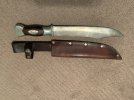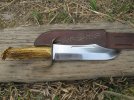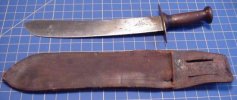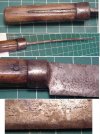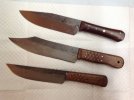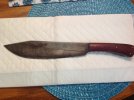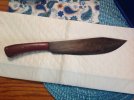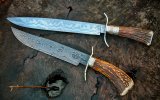-
The BladeForums.com 2024 Traditional Knife is available! Price is $250 ea (shipped within CONUS).
Order here: https://www.bladeforums.com/help/2024-traditional/
You are using an out of date browser. It may not display this or other websites correctly.
You should upgrade or use an alternative browser.
You should upgrade or use an alternative browser.
It’s a new year, so let’s see everyone’s favorite candidate for Bowie’s Alamo knife.
- Thread starter not2sharp
- Start date
cbach8tw
Platinum Member
- Joined
- Jan 9, 2006
- Messages
- 12,531
The sandbar knife was described as a large “butcher” knife. The Alamo knife was believed to have been a different knife.
n2s
Yup. I believe the sandbar knife was more like a Butcher knife, more like the Forest Bowie in shape and construction. Or even the Jesse Clift Bowie. No one knows for sure what it was exactly like. There was a good article in Knife magazine a long time ago comparing the Forest knife to the Clift knife, not the same maker necessarily, but in style. The Alamo Bowie that JB had is wrapped up a mystery too, though not as much as the sandbar knife. And I think it was different from the sandbar knife, maybe a Searles type knife, a more refined knife. I think the idea of the Alamo Bowie looking close to the Musso Bowie with a clip point and brass spine guard is remnant of the Iron Mistress movie magic. More Hollywood than historical fact. We went to San Antonio and the Alamo in 2017, and to the right of the front entrance, they had a good presentation about Bowie and the Bowie knife in general, and the different styles that developed. There is also a lot theories of what happened to the Alamo Bowie after the battle. Makes for some good reading.
Last edited:
not2sharp
Platinum Member
- Joined
- Jun 29, 1999
- Messages
- 20,569

This is where they start getting tricky. I collected this in Chile several decades back, but suspect that it may actually be from Guam, where the Chamorro population has been known to have produce similar knives until recently. Since Guam would have been a part of the Spanish Empire through the Spanish American War, we can see where the traits we associate with the Bowie may have originated.
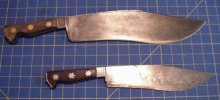
The two knives shown above are more "modern" Chamorro knives from the Inter-War years
n2s
not2sharp
Platinum Member
- Joined
- Jun 29, 1999
- Messages
- 20,569
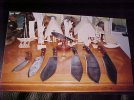
The knives above were still being made in Guam during the late 1990s. Their last traditional knife maker has since passed. It had been a long standing family tradition, but none of his heirs were interesting in taking up the trade at the time.
This was he:
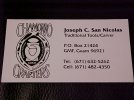
I had the opportunity to correspond with him and he was confident that his relatives had made the two knifes pictured above (c. 1920-30s).
n2s
Modoc ED
Gold Member
- Joined
- Mar 28, 2010
- Messages
- 14,382
Bought this Case Bowie back in 1964 in Martin's Hardware Store on U.S. Route 1 just south of Alexandria, Virginia. Davy Crockett himself engraved his likeness on the blade and while engraving his likeness, said it was a "Bold Faced Lie" that he had been killed at the Alamo and went on to say that Jim Bowie hadn't been killed there either. He said they were camping over at Fort Hunt Park over near Mt. Vernon - the home of George Washington.


kamagong
Gold Member
- Joined
- Jan 13, 2001
- Messages
- 10,966
Bought this Case Bowie back in 1964 in Martin's Hardware Store on U.S. Route 1 just south of Alexandria, Virginia. Davy Crockett himself engraved his likeness on the blade and while engraving his likeness, said it was a "Bold Faced Lie" that he had been killed at the Alamo and went on to say that Jim Bowie hadn't been killed there either. He said they were camping over at Fort Hunt Park over near Mt. Vernon - the home of George Washington.

Jim Bowie looks an awful lot like Fess Parker.
Modoc ED
Gold Member
- Joined
- Mar 28, 2010
- Messages
- 14,382
Jim Bowie looks an awful lot like Fess Parker.
Funny you should bring that up Christian. While Davy was engraving the knife he did mention that the Producers of the TV Show "Davy Crockett" and Fess Parker were paying him a small royalty which kept he and Jim Bowie flush with enough money for tobacco, liquor, beans, and the occasional dalliance in wine, women, and song.
kamagong
Gold Member
- Joined
- Jan 13, 2001
- Messages
- 10,966
Funny you should bring that up Christian. While Davy was engraving the knife he did mention that the Producers of the TV Show "Davy Crockett" and Fess Parker were paying him a small royalty which kept he and Jim Bowie flush with enough money for tobacco, liquor, beans, and the occasional dalliance in wine, women, and song.
Excellent.

cbach8tw
Platinum Member
- Joined
- Jan 9, 2006
- Messages
- 12,531
Those knives from Guam look heavy, how did they feel in use? More like a cleaver or a barong? You know these look great but have to be eliminated as an Alamo Enterprise Bowie, they had no idea where Guam was or even if it existed at that time. I was wondering what traditional Filipino or Montagnard weapons looked like, they also could be an Alamo knife. If Guam can, why not other SE Asia indigenous knives? Just for fun of course. 
knowtracks
Gold Member
- Joined
- Jan 16, 2006
- Messages
- 3,893
- Joined
- Dec 29, 2007
- Messages
- 2,261
View attachment 1484026
The knives above were still being made in Guam during the late 1990s. Their last traditional knife maker has since passed. It had been a long standing family tradition, but none of his heirs were interesting in taking up the trade at the time.
This was he:
View attachment 1484028
I had the opportunity to correspond with him and he was confident that his relatives had made the two knifes pictured above (c. 1920-30s).
n2s
I've read about the Guam connection of that knife design but I can tell you from first hand experience they sell the same pattern in some Mexican cutlery stores in several sizes. Not sure who did it first.
tongueriver
Gold Member
- Joined
- Dec 28, 2007
- Messages
- 5,404
delete
Last edited:
- Joined
- Dec 2, 2005
- Messages
- 71,121
Cool thread, with some great-looking knives 

This is a knife from the wall of the Jim Bowie Diner in Sheffield




This is a knife from the wall of the Jim Bowie Diner in Sheffield



not2sharp
Platinum Member
- Joined
- Jun 29, 1999
- Messages
- 20,569
Those knives from Guam look heavy, how did they feel in use?....
They feel like most modern camp knives. They are heavy but not oppressively so. These were made to be carried and used. There is a small segment in the classic documentary Victory at Sea that shows a local in Guam using one of these to repair and thatch his roof.
n2s




